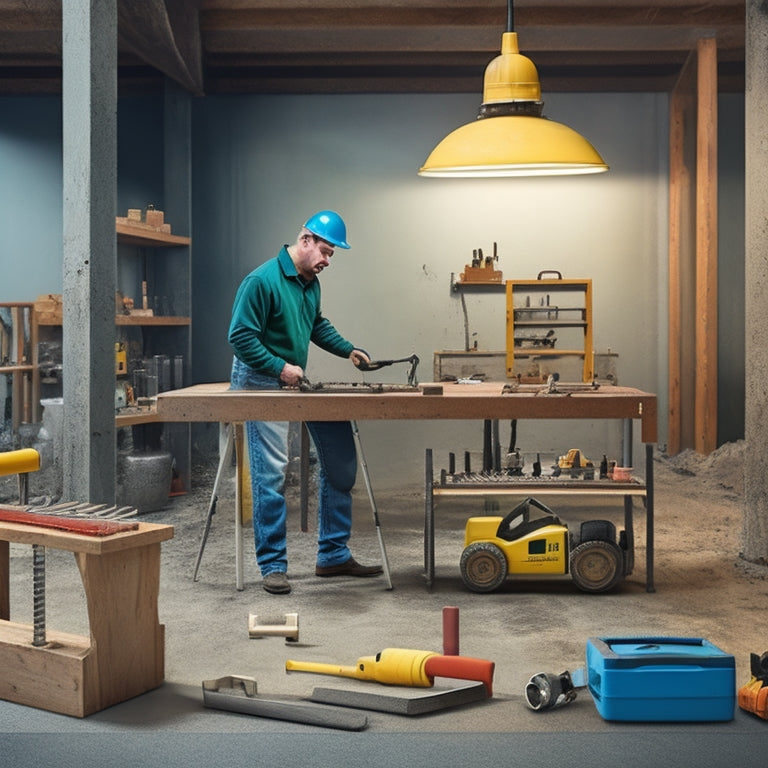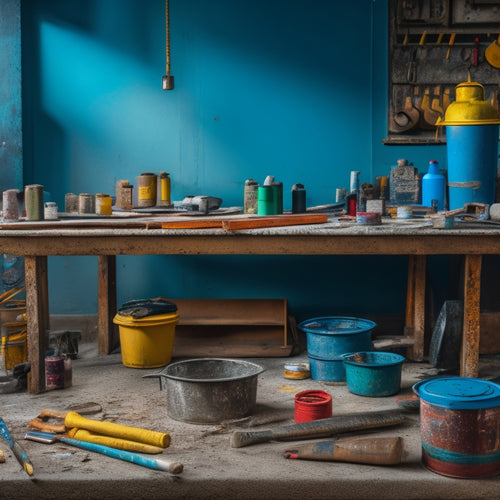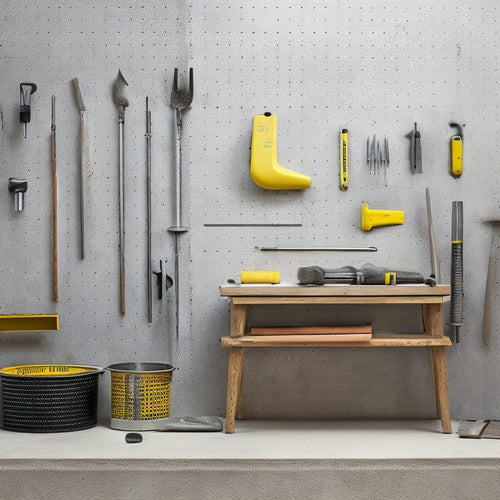
Choose the Right Concrete Leveling Tools Easily
Share
To choose the right concrete leveling tools easily, you'll need to start by evaluating your project's specific requirements, contemplating factors like the type of concrete, its age, and the desired outcome. From there, you can explore the various types of tools available, including leveling equipment, pumps/injectors, and lifting/raising tools, as well as specialized tools like scarifiers and grinders. When selecting tools, prioritize durability, ease of use, and safety features, and don't forget to take into account your budget and cost-effectiveness. By taking a methodical approach, you'll be well on your way to finding the ideal tools for your project, and taking the next step towards a successful outcome.
Key Takeaways
• Assess the concrete leveling project's specific needs, considering the type of concrete, its age, and the desired outcome to choose the right tools.
• Select tools based on the project's size, complexity, and unique characteristics to ensure the right technique is used.
• Consider the durability and material quality of tools, as well as their weight, size, and portability, to ensure ease of use and effectiveness.
• Choose tools with advanced features like precision measurement, ergonomic design, and user-friendly controls to enhance accuracy and ease of use.
• Prioritize safety features, emergency response plans, and proper handling of hazardous materials to ensure a safe and successful project.
Determine Your Leveling Needs
You need to identify the specific requirements of your concrete leveling project to select the right tools for the job. This involves conducting a thorough project assessment to determine the scope, size, and complexity of the task at hand.
Take into account the type of concrete, its age, and the extent of the damage or unevenness. Consider the desired outcome, whether it's to restore a smooth surface or to achieve precise leveling for a specific application.
Different leveling techniques may be required depending on the project's unique characteristics. For instance, some projects may necessitate the use of specialized equipment for lifting and stabilizing, while others may require more subtle adjustments.
Types of Concrete Leveling Tools
When it comes to choosing the right concrete leveling tools for your project, you'll need to evaluate the type of equipment that best suits your needs.
You'll have three main categories to choose from: concrete leveling equipment, pumps and injectors, and lifting and raising tools.
Concrete Leveling Equipment
Concrete leveling projects require a range of specialized tools, including pumps, drilling equipment, and grout mixing systems, to accurately and efficiently lift and stabilize uneven concrete surfaces.
As you prepare for your concrete leveling project, it's important to familiarize yourself with the various types of equipment involved.
When it comes to surface preparation, you'll need tools such as scarifiers, grinders, and saws to remove old coatings, clean the surface, and create a bondable substrate.
For concrete leveling techniques that involve drilling, you'll need drilling equipment like hammer drills, rotary hammers, and core drills to create holes for injection ports or to remove damaged concrete.
Additionally, you may require mixing equipment like grout mixing systems and pumps to prepare and inject the leveling material into the drilled holes.
Having the right concrete leveling equipment guarantees a successful project outcome, so it's vital to choose the right tools for the job.
Pumps and Injectors
Two vital components of a concrete leveling system are pumps and injectors, which work in tandem to accurately deliver leveling materials into the drilled holes or voids.
You'll want to understand the importance of pump maintenance to guarantee efficient and consistent material flow. Regular cleaning and lubrication of pump components can prevent clogs and extend the lifespan of your equipment.
When selecting injectors, you'll encounter various types, each designed for specific applications. For instance, you might opt for a high-pressure injector for larger voids or a low-pressure injector for smaller, more delicate areas.
Some injectors are designed for self-leveling materials, while others are better suited for thicker, more viscous materials. Regardless of the type, it's essential to choose an injector that matches the material you're working with and the specific requirements of your project.
Lifting and Raising
You'll need to select the right lifting and raising tools to physically lift the sunken concrete slabs into place, guaranteeing a stable and even surface. These tools are designed to apply the necessary force to lift the concrete, and they come in various types and sizes. Hydraulic jacks, pneumatic lifters, and mechanical lifters are popular options, each with its own unique features and capabilities.
When choosing a lifting and raising tool, consider the weight and size of the concrete slab, as well as the type of lifting technique or raising method required. For instance, hydraulic jacks are ideal for heavy loads, while pneumatic lifters are better suited for smaller, more precise lifts. Mechanical lifters, on the other hand, offer a more manual approach to lifting.
It's essential to select a lifting and raising tool that aligns with your specific concrete leveling project's needs. By doing so, you'll guarantee a safe, efficient, and effective lifting process that yields the desired results.
Remember to always follow the manufacturer's instructions and take necessary safety precautions when operating these tools to avoid accidents and injuries.
Tool Material and Durability
The selection of a durable tool material is essential, as it directly impacts the effectiveness and lifespan of your concrete leveling equipment.
You'll want to choose materials that can withstand the rigors of lifting and raising heavy concrete slabs, as well as the corrosive properties of the concrete itself. When considering tool material, think about tool longevity – will it last for multiple projects, or will it wear out quickly?
Material selection is critical in guaranteeing your tools can handle the demands of concrete leveling.
Look for high-strength, corrosion-resistant materials like stainless steel or heavy-duty alloys. These materials can withstand the heavy loads and harsh environments often encountered in concrete leveling projects.
Additionally, consider the surface finish of the tool material – a smooth, rust-resistant finish can help reduce friction and prevent damage to the surrounding concrete.
Size and Weight Considerations
Taking into account the logistics of transporting and maneuvering your concrete leveling equipment, it's essential to factor in the size and weight of your tools. Oversized or excessively heavy equipment can hinder your ability to navigate tight spaces and increase the risk of accidents.
When selecting concrete leveling tools, you should prioritize portability options that allow for easy transportation and storage. Look for tools with ergonomic designs that reduce fatigue and strain, making it easier to work for extended periods.
You'll also want to reflect on the weight distribution of your tools, guaranteeing they're balanced and easy to handle. This is particularly important when working on uneven or inclined surfaces, where stability is key.
Additionally, take into account the space constraints of your work area and choose tools that can fit comfortably within those boundaries. By factoring in size and weight considerations, you can secure a safer, more efficient, and more effective concrete leveling process.
Ultimately, the right tools will enable you to complete your project with confidence and precision.
Leveling Accuracy and Precision
As you select concrete leveling tools, precision and accuracy become paramount, since even slight deviations from the desired level can compromise the structural integrity and aesthetic appeal of the finished surface. You need tools that can guarantee precise leveling, especially when working with critical applications like industrial flooring or high-traffic areas.
To achieve this, you'll want to take into account leveling techniques that incorporate advanced measurement tools. For instance, laser leveling systems can provide accurate readings to within a fraction of an inch, allowing you to make precise adjustments. Additionally, digital inclinometers can measure angles and slopes with high accuracy, giving you confidence in your leveling work.
When evaluating concrete leveling tools, look for features like adjustable sensitivity, automatic calibration, and data logging capabilities to guarantee accurate and reliable measurements. By choosing tools with these advanced features, you can achieve the high level of precision required for demanding applications.
Ease of Use and Handling
You'll find that precision and accuracy in concrete leveling tools are only half the battle, and that ease of use and handling are equally important for efficiently completing a project. A tool that's difficult to handle or operate can slow you down, increasing the time and labor required to finish the job.
Look for tools with user-friendly features, such as ergonomic grips, balanced weight distribution, and intuitive controls. These features will reduce fatigue and make it easier to maneuver the tool, allowing you to focus on achieving the perfect level.
When evaluating concrete leveling tools, consider the handling techniques required to operate them effectively. Do you need to apply excessive force or make complex adjustments? Or can you simply set the tool and let it do the work?
Opt for tools with straightforward operating procedures and minimal setup requirements. By choosing a tool that's easy to use and handle, you'll be able to work more efficiently, reduce errors, and achieve professional-grade results with minimal effort.
Safety Features and Precautions
When choosing concrete leveling tools, you'll want to prioritize safety above all else.
You're about to work with heavy machinery, hazardous materials, and uneven surfaces, so it's crucial to take precautions to protect yourself and others on the job site.
As you evaluate different tools, make sure they come with essential safety features, such as protective gear, proper material handling, and emergency response plans.
Wear Protective Gear
Wearing protective gear, including gloves, safety glasses, and a dust mask, is essential to prevent injuries and exposure to hazardous materials during concrete leveling operations.
You must prioritize your safety and the safety of those around you. When working with concrete, you're dealing with heavy materials, loud machinery, and potential chemical exposure. Meeting safety standards is vital to avoid accidents and long-term health risks.
As you prepare for your concrete leveling project, make sure you have the right protective gear. Inspect your gloves for any signs of wear or damage, and replace them if necessary.
Your safety glasses should provide clear visibility and protection from debris. Don't forget a dust mask to prevent inhaling hazardous particles. Always follow the manufacturer's instructions for each piece of protective gear.
Hazardous Material Handling
Before handling hazardous materials, identify the specific chemicals involved in your concrete leveling process and familiarize yourself with their safety data sheets (SDS) to confirm you're aware of potential risks and necessary precautions. This information will help you take the right steps to minimize exposure and guarantee proper handling, storage, and disposal of hazardous waste.
When working with hazardous materials, it's crucial to follow strict guidelines for material disposal. Improper disposal can lead to environmental contamination and put people's health at risk. Here are some guidelines to keep in mind:
| Material | Handling Precautions | Disposal Methods |
|---|---|---|
| Chemical hardeners | Wear gloves, goggles, and a face mask | Dispose of in designated hazardous waste containers |
| Acid-based cleaners | Wear protective clothing, ventilate the area | Neutralize with a base before disposal in a designated area |
| Epoxy resins | Wear gloves, goggles, and a face mask | Dispose of in designated hazardous waste containers |
| Solvents | Wear gloves, goggles, and a face mask | Dispose of in designated hazardous waste containers |
Remember to always follow the manufacturer's instructions and local regulations for hazardous waste disposal. By taking the necessary precautions, you can confirm a safe and environmentally responsible concrete leveling process.
Emergency Response Plans
You should establish an emergency response plan that outlines procedures for accidents, spills, or other incidents that may occur during the concrete leveling process. This plan should identify potential hazards, designate emergency response teams, and outline procedures for reporting and containing incidents.
Having a clear emergency response plan in place will enable you to respond quickly and effectively in the event of an emergency, minimizing the risk of injury or property damage.
Your emergency response plan should also include procedures for emergency preparedness, such as having a first aid kit on site, maintaining a list of emergency contact numbers, and designating a meeting point for employees in the event of an evacuation.
Crisis management is also a critical component of emergency response planning, as it enables you to manage the aftermath of an incident and restore normal operations as quickly as possible.
Budget and Cost-Effectiveness
Your budget plays a significant role in determining the type of concrete leveling tools you can afford, and it's vital to balance cost-effectiveness with the quality of equipment needed to get the job done efficiently.
When planning your budget, consider the cost comparison of different tools and equipment. You'll want to identify the most cost-effective options that meet your project's requirements. Conduct a thorough cost comparison to determine which tools provide the best value for your money.
Budget planning is essential in concrete leveling projects. You'll need to allocate funds for equipment, materials, and labor. By prioritizing your needs and wants, you can create a realistic budget that guarantees you get the right tools for the job.
Consider the long-term benefits of investing in high-quality equipment, such as reduced maintenance costs and increased productivity. By balancing cost-effectiveness with quality, you'll be able to complete your project efficiently and within budget.
Frequently Asked Questions
Can I Use Concrete Leveling Tools for Other Construction Tasks?
You're wondering if concrete leveling tools can be used for alternative tasks beyond their primary purpose. The answer is yes, many of these tools showcase impressive versatility.
For instance, a laser level can help with alignment during tile installation, while a screed board can be used for smoothing freshly poured concrete.
How Often Should I Maintain and Clean My Leveling Tools?
Did you know that 75% of tool failures are attributed to poor maintenance? You're wise to prioritize upkeep!
To guarantee peak performance, establish a regular maintenance schedule for your concrete leveling tools. Clean them after each use, using gentle techniques to prevent damage.
Regularly inspect and replace worn parts, and store them in a dry, protected area. By doing so, you'll extend their lifespan and assure accurate results.
Are There Any Eco-Friendly Concrete Leveling Tool Options?
When considering eco-friendly concrete leveling tool options, you'll want to explore tools made from sustainable materials, such as recycled steel or bamboo.
Look for manufacturers that prioritize environmentally responsible production processes.
Additionally, consider alternative methods, like using foam jacking or polyurethane injection, which reduce waste and minimize environmental impact.
Can I Rent Concrete Leveling Tools Instead of Buying Them?
You're considering renting concrete leveling tools instead of buying them, which is a smart move.
When you rent, you'll save on upfront costs and storage space.
Compare the rental fees to the purchase price, and you might find that renting is more cost-effective, especially for infrequent or small-scale projects.
Additionally, rental benefits include access to specialized tools and reduced maintenance responsibilities, allowing you to focus on the task at hand.
Do I Need Special Training to Operate Concrete Leveling Tools?
Did you know that 75% of concrete leveling projects require specialized equipment?
When it comes to operating concrete leveling tools, you're likely wondering if you need special training. The answer is yes, you do.
Training requirements vary by tool and manufacturer, but understanding tool safety is essential to avoid accidents and guarantee successful leveling.
You'll need to familiarize yourself with the tool's operating manual, safety guidelines, and best practices to secure a smooth project execution.
Conclusion
You've done your research and weighed your options carefully. Now, you're ready to choose the right concrete leveling tools for your project.
Don't let the initial investment deter you - remember, cheap tools can lead to subpar results and costly rework.
Invest in quality tools that will deliver accurate and precise results, ensuring a safe and efficient leveling process that meets your project's specific needs.
Related Posts
-

Essential Tools for Painting Concrete Walls
When painting concrete walls, you'll need a range of specialized tools to achieve a professional-looking finish. Star...
-

10 Must-Have Tools for Concrete Repair Organization
You'll need a solid organization system to keep your concrete repair tools and materials within easy reach, protected...
-

Top Tools for Concrete Repair Success
When it comes to concrete repair success, you'll need a well-stocked toolkit with essential hand tools like trowels, ...


